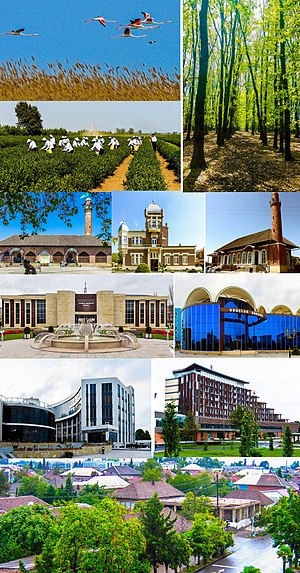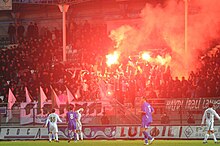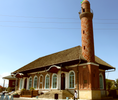world.wikisort.org - Azerbaijan
Lankaran (Azerbaijani: Lənkəran, ![]() (listen)) is a city in Azerbaijan, on the coast of the Caspian Sea, near the southern border with Iran. As of 2021, the city had a population of 89,300. It is next to, but independent of, Lankaran District. The city forms a distinct first-order division of Azerbaijan.
(listen)) is a city in Azerbaijan, on the coast of the Caspian Sea, near the southern border with Iran. As of 2021, the city had a population of 89,300. It is next to, but independent of, Lankaran District. The city forms a distinct first-order division of Azerbaijan.
Lankaran
Lənkəran | |
|---|---|
City | |
 | |
 Lankaran | |
| Coordinates: 38°45′13″N 48°51′04″E | |
| Country | |
| Region | Lankaran-Astara |
| Government | |
| • Governor | Taleh Qarashov |
| Area | |
| • Total | 70 km2 (30 sq mi) |
| Population (2021)[1] | |
| • Total | 89,300[2] |
| Time zone | UTC+4 (AZT) |
| Area code | +994 025 25 |
| Website | lenkeran-ih |
Etymology
The old form of the name was "Langarkanan" that in Persian means "the place of pulling up the anchor(s)" : "Langar" (لنگر, anchor) + "kan" (کن, to pull) + "an"(آن, suffix of places). However, some sources state that Lankaran is said to come from the Talish words for 'Cane house', which sounds as 'Lan Kəon'.[3][4] Alternatively, from Median *Lan(a)karan-, where *karan- means 'border, region, land' and Lan is probably a name of a Caspian tribe.[5]
History
The city was built on a swamp along the northern bank of the river bearing the city's name. There are remains of human settlements in the area dating back to the Neolithic period as well as ruins of fortified villages from the Bronze and Iron Ages.[6]
With the death of Nader Shah (r. 1736–1747), the Talysh Khanate was founded by a certain Seyyed Abbas, whose ancestors were members of the Iranian Safavid dynasty, and had moved into the Talish region in the 1720s during a turbulent period in Iranian history. From the founding of the khanate until 1828, it was under the suzerainty of the Iranian Zand and Qajar dynasties. In the first half of the 18th century, the Russians gained control over it for a few years during the Russo-Persian War of 1722–1723; in 1732 it was ceded back to Iran by the Treaty of Resht. During the Russo-Persian War of 1804–1813, General Kotlyarevsky, heading the southernmost Russian contingent during the war, stormed and captured Lankaran's fortress. Following the Treaty of Gulistan of 1813, it was ceded to Russia.[7] Qajar Iran would later retake the city during the Russo-Persian War of 1826–1828, but was forced to return it following the Treaty of Turkmenchay (1828), which saw the definite end of Persian influence in the South Caucasus.[7]
Under Russian rule, Lankaran, known as Lenkoran (Ленкорань) in Russian, was the center of the Lenkoran Uyezd of the Baku Governorate. Following the collapse of the Russian Empire, it was a part of the short-lived Azerbaijan Democratic Republic (1918–1920), then became a part of the Azerbaijan Soviet Socialist Republic following the sovietization of Azerbaijan. In 1991, following the dissolution of the Soviet Union, it became a part of independent Azerbaijan.
Geography
There are sandy beaches near Lankaran. Thermal sulphide, chloride, sodium-calcium waters of Andjin (Upper and Lower) mineral springs are situated 12 km west of the town. Also to the west are the ruins of Ballabur castle, near the village with the same name.
The region has a vast area of national parks, where a variety of fauna and flora are preserved. Gizil-Agach State Reserve hosts over 250 kinds of plants, 30 species of fish and more than 220 kinds of birds. Lankaran is also known for Parrotia, or ironwood. It is naturally grown in the region and could be seen in Hirkan National Park. Local myth has it that it is the only wood that sinks in water, hence the name (ironwood). Historically it has been used for heating since it burns for a long time and is not easily extinguished. The Persian leopard (Panthera pardus saxicolous) subspecies of the leopard, lives in the national park as well. In 1937, members of the Opilio lepidus species of harvestman were sighted in the area.[8]
Climate
Lankaran has a hot-summer Mediterranean climate (Köppen climate classification: Csa), with cool, wet winters and very warm, partially dry/highly humid summers.
| Climate data for Lenkaran | |||||||||||||
|---|---|---|---|---|---|---|---|---|---|---|---|---|---|
| Month | Jan | Feb | Mar | Apr | May | Jun | Jul | Aug | Sep | Oct | Nov | Dec | Year |
| Average high °C (°F) | 7.2 (45.0) |
7.2 (45.0) |
11.0 (51.8) |
17.5 (63.5) |
22.5 (72.5) |
27.2 (81.0) |
30.4 (86.7) |
29.5 (85.1) |
25.9 (78.6) |
19.9 (67.8) |
14.1 (57.4) |
10.1 (50.2) |
18.5 (65.4) |
| Average low °C (°F) | 0.0 (32.0) |
1.0 (33.8) |
3.9 (39.0) |
8.6 (47.5) |
13.1 (55.6) |
17.5 (63.5) |
20.1 (68.2) |
19.7 (67.5) |
16.9 (62.4) |
11.8 (53.2) |
6.7 (44.1) |
2.5 (36.5) |
10.2 (50.3) |
| Average precipitation mm (inches) | 91 (3.6) |
114 (4.5) |
90 (3.5) |
50 (2.0) |
54 (2.1) |
22 (0.9) |
17 (0.7) |
50 (2.0) |
143 (5.6) |
259 (10.2) |
168 (6.6) |
88 (3.5) |
1,146 (45.2) |
| Average precipitation days | 10 | 10 | 11 | 8 | 8 | 3 | 2 | 4 | 7 | 13 | 12 | 9 | 97 |
| Mean monthly sunshine hours | 105.4 | 98.9 | 124.0 | 171.0 | 226.3 | 282.0 | 306.9 | 254.2 | 189.0 | 127.1 | 99.0 | 108.5 | 2,092.3 |
| Source 1: World Meteorological Organization (UN) [9] | |||||||||||||
| Source 2: Hong Kong Observatory(sun only)[10] | |||||||||||||
Economy
Dominating spheres in the economy of Lankaran are vegetable-growing, tea-growing, paddy cultivating, cattle-breeding, citrus plants, beekeeping, fishing, and grain farming.[11] Favourable humid subtropical climate, availability of good arable land, water and sufficient labour resources of the city provides a good basis for agricultural activities as well as the development of agro-processing enterprises. The city is also home to Azerbaijan's first tea plant, built in 1937.[12]
Demographics
The vast majority of the population of Lankaran is Talysh, and the rest are Azerbaijanis and other nationalities.
Religion
The religion with the largest community of followers is Islam. The majority of the Muslims are Shia Muslims, and the Republic of Azerbaijan has the second-highest Shia population percentage in the world after Iran.[13] The city's notable mosques include Kichik Bazar Mosque and Boyuk Bazar Mosque.[14]
Culture
As of 2012, the city along with Baku and Ganja participated in Earth Hour movement.[15][16]
Cuisine
Lankaran's cuisine has largely been affected by its multicultural history, hence the large variety of food originating during Talysh Khanate. Lankaran's signature cuisine includes lavangi, Lankaran kulcha, marji plov, white plov, pumpkin plov and turshu kebab.[17][18][19]
Music and media

Lankaran is home to several national folk performers, including the Bacılar (The Sisters) national Talysh folk and dance collective.[20]
The regional channel Janub TV and newspaper Lankaran are headquartered in the city.[21]
Sports

The city used to have a professional football team competing in the top-flight of Azerbaijani football - Khazar Lankaran, which played in the Azerbaijan Premier League. Sporting venues in the city include the Lankaran City Stadium and Lankaran Olympic Sports Complex.[22] The stadium was one of the venues for the group stages of the 2012 FIFA U-17 Women's World Cup.[23]
In 2012, the city won to host European Masters Weightlifting Championship.[24]
Transport
Air
The Lankaran International Airport's international terminal was opened in September 2008.[25]
Railway
The city has rail service from historic terminals in downtown to Baku in the east and Astara in the south.[26][27]
Education
This section needs expansion. You can help by adding to it. (November 2014) |
The following universities are located in Lankaran:
- Lankaran State University – founded in 1991, Lankaran State University is Lankaran's first university to start courses.


Notable people
The city's notable residents include: Major-General of the Soviet armoured troops during World War II Hazi Aslanov, General of the Artillery in the Imperial Russian Army Samad bey Mehmandarov, folk singer and theatre actress Jahan Talyshinskaya, social activist Maryam Bayramalibeyova, pop singer Ilhama Gasimova, weightlifter Turan Mirzayev, singer Hagigat Rzayeva and footballer Dmitriy Kramarenko.[28][29]
Twin towns
Lankaran is twinned with:[30]
 Monterey, United States (since 2011)
Monterey, United States (since 2011) Iskenderun, Turkey
Iskenderun, Turkey Cerveteri, İtalia (since 2013)
Cerveteri, İtalia (since 2013)
Gallery
- The central street of Lankaran
- Lankaran Springs & Wellness Resort
- Dosa Park
 Boyuk Bazar Mosque
Boyuk Bazar Mosque Kichik Bazar Mosque
Kichik Bazar Mosque- Forest Station
- Hotel Gala
- Zindan Fortress
- Sutamurdov bridge
See also
- Lankaran Lowland
References
- "Əhalisi - LƏNKƏRAN ŞƏHƏR Icra Hakimiyyəti". lenkeran-ih.gov.az (in Azerbaijani). 1 January 2018. Archived from the original on 19 June 2018. Retrieved 19 June 2018.
- Governorship of Lankaran
- lənkəran on ozaramizdi.org[permanent dead link] (in Azerbaijani)
- "Lənkəran haqqında tarixi coqrafi məlumat". Archived from the original on January 30, 2011.
- А. Периханян (1982), Этимологические заметки // Историко-филологический журнал. Ереван. № 1, pp. 55-62
- History of Lankaran Archived 2011-07-06 at the Wayback Machine
- Timothy C. Dowling Russia at War: From the Mongol Conquest to Afghanistan, Chechnya, and Beyond pp 728-730 ABC-CLIO, 2 dec. 2014 ISBN 978-1598849486
- Nataly Y. Snegovaya (2007). "Two New Harvestman Species from Lenkoran, Azerbaijan (Arachnida: Opiliones: Phalangiidae)" (PDF). Bulletin of the British Arachnological Society. 14 (2): 88–92.
- "World Weather Information Service – Lenkaran". United Nations. Retrieved 19 January 2011.
- "Climatological Information for Lankaran, Azerbaijan". Hong Kong Observatory. Archived from the original on October 25, 2019. Retrieved November 17, 2012.
- Business opportunities of the region Archived 2011-07-13 at the Wayback Machine
- "PASHA". www.pasha.az.
- Juan Eduardo Campo,Encyclopedia of Islam, p.625
- "Culture in Lankaran" (in Azerbaijani). Retrieved 13 November 2014.
- "Azerbaijan to join Earth Hour". www.news.az. Archived from the original on 29 November 2014. Retrieved 17 November 2014.
- "IDEA campaign to hold Earth Hour action". en.trend.az. Retrieved 17 November 2014.
- Azerbaijani Cuisine: Şirniyyat Archived 2008-11-20 at the Wayback Machine (in Azerbaijani)
- Cuisine of Lankaran Archived 2011-07-06 at the Wayback Machine
- Azərbaycanın subtropik zonası Archived 2009-09-14 at the Wayback Machine (in Azerbaijani)
- ""Bacılar" talış folklor mahnı və rəqs kollektivi". Archived from the original on March 4, 2016.
- "Radio-TV yayımı" (in Azerbaijani). Retrieved 13 November 2014.
- "Lankaran Olympic Sport Complex". www.noc-aze.org. Archived from the original on 29 November 2014. Retrieved 18 November 2014.
- "France end Asian domination". fifa.com. FIFA. Retrieved 6 July 2013.
- "Weightlifting Masters". Official Website of European Masters Weightlifting 2012. Archived from the original on 20 April 2011. Retrieved 19 March 2011.
- Lənkəranda çay plantasiyalarının sahəsi genişləndirilir[permanent dead link] (in Azerbaijani)
- "Unknown Host". Archived from the original on 26 February 2020.
- Turizm müəssisələri Archived 2009-04-05 at the Wayback Machine (in Azerbaijani)
- (in Azerbaijani) The Voice of Happiness and Optimism: Jahan Talyshinskaya by Afruz Mammadova. Musigi-dunya.az
- Асланов Ази Ахад оглы (in Russian). Heroes of the country.
- "Sister Cities". City of Monterey. Retrieved 2020-06-26.
External links
- Official city webpage - (English version)
- Lankaran State University
- Soviet topographic map 1:100,000 (published in 1991)
- Satellite photo via Google Maps
- History
- Economy
- Lankaran (as Lənkəran) at GEOnet Names Server
На других языках
[de] Lənkəran (Stadt)
Lənkəran, dt. auch Länkäran (russisch Ленкорань .mw-parser-output .Latn{font-family:"Akzidenz Grotesk","Arial","Avant Garde Gothic","Calibri","Futura","Geneva","Gill Sans","Helvetica","Lucida Grande","Lucida Sans Unicode","Lucida Grande","Stone Sans","Tahoma","Trebuchet","Univers","Verdana"}Lenkoran), ist eine Stadt im Süden von Aserbaidschan am Kaspischen Meer. Die Stadt liegt inmitten des Rayons Lənkəran, dessen Verwaltungssitz sie ist, zu dem sie aber als Stadt mit Rayonstatus nicht selbst gehört. Lənkəran hat 52.900 Einwohner (Stand: 2021). 2014 betrug die Einwohnerzahl etwa 51.300.[2]- [en] Lankaran
[ru] Ленкорань
Ленкорань[3] (азерб. Lənkəran, тал. Lankon) — город в Азербайджане, административный центр Ленкоранского района.Другой контент может иметь иную лицензию. Перед использованием материалов сайта WikiSort.org внимательно изучите правила лицензирования конкретных элементов наполнения сайта.
WikiSort.org - проект по пересортировке и дополнению контента Википедии








